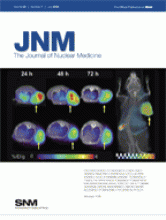REPLY: We thank Pantaleo et al. for their kind remarks about our work (1). We would like to take this opportunity to briefly elaborate on the complex relationship between epidermal growth factor receptor (EGFR) pattern and its molecular imaging.
11C-radiolabeled PD153035 was verified as a powerful EGFR-specific imaging agent by many studies (2,3). The group of Shandong Tumor Hospital has a longstanding interest and expertise on the subject of EGFR molecular imaging with 11C-PD153035. Our objective in publishing the article was to point out the excellent biodistribution and radiation dosimetry of 11C-PD153035 in humans. Also, our preliminary work has partly proved the correlation between EGFR protein expression and 11C-PD153035 uptake in patients with non–small cell lung cancer (NSCLC) (4).
As Pantaleo et al. pointed out, reversible compounds may have a high non–tumor-specific uptake at their binding site with intracellular adenosine triphosphate (5). But PD153035 can bind the intracellular tyrosine kinase (TK) domain of EGFR and inhibits EGFR function with high affinity (inhibitory concentration of 50%, 5.2 nM in vitro). Our pilot work in NSCLC patients also showed a significant difference in 11C-PD153035 uptake between tumor mass and normal tissue. Twenty minutes after intravenous injection, the tumor-to-blood and tumor-to-lung ratios of 11C-PD153035 were 2.45 ± 1.08 and 4.21 ± 1.90, respectively (4). We regard this high contrast of 11C-PD153035, especially in the lung, as a good characteristic for a probe.
Today, clinical data on TK inhibitor in NSCLC indicate significant variability in treatment responsiveness. The EGFR-targeted drugs show activity independently of EGFR expression but correlate with EGFR gene copies, exon mutation, and K-ras mutation. Thus, there is less interest in the detection of receptor expression. We agree that we should pay more attention to both activation of the receptor and its downstream signaling pathway. Actually, we regard these issues to be a priority in order for a radiolabeled TK inhibitor to work as an EGFR molecular tracer that can honestly reflect EGFR TK pattern. Radiolabeled EGFR antibody or epidermal growth factor can bind separate, extracellular EGFR, potentially causing nonspecific images. Molecular images obtained by radiolabeled EGFR antibody or epidermal growth factor can detect EGFR expression level only on the cell membrane and may be influenced by a disordered distribution of tumor blood vessels. Radiolabeled EGFR antibody or epidermal growth factor cannot detect intracellular TK activity directly or the true status of the EGFR signaling pathway. EGFR-independent TK activation by gene mutation cannot be displayed by these tracers. The superiority of radiolabeled TK inhibitor over radiolabeled antibody, epidermal growth factor, or small molecular Affibody (Affibody AB) is obvious. Radiolabeled gefitinib, erlotinib, and PD153035 can specifically bind EGFR TK in vitro. Though some tracers may accumulate in the cell membrane of normal tissue because of high lipophilia, we believe that the EGFR activation status can be strictly displayed by them in vivo. On this basis, we speculate that EGFR molecular imaging can be divided into 2 types. One is radiolabeled TK inhibitor, which can predict or monitor the treatment response of TK inhibitor, the other is radiolabeled antibody or Affibody/Nanobody (Ablynx), which can predict or monitor antibody treatment. Moreover, radiolabeled erlotinib and gefitinib have the same chemical structures as the non–isotope-labeled compounds. They can be further applied to assess successful blocking of EGFR by therapeutic agents, thereby providing essential information for the dose and dose scheduling of EGFR antagonists.
Recently, a study showed that EGFR PET may depend strictly on the functional and mutational status of the receptor through the specific use of activated or mutated cell lines (6). But our preliminary work in NSCLC patients did not demonstrate a close correlation between 11C-PD153035 uptake and EGFR gene mutation or gene copies (7). Thus, 11C-PD153035 is of poor value for predicting gene mutation or amplification of EGFR. But the small number of patients in our study may have somewhat decreased the reliability of the results. In addition, the tumors were of diverse histologic types. In fact, EGFR gene mutation is more prevalent in adenocarcinoma. Our data were acquired in 14 patients with NSCLC, whereas the patients with adenocarcinoma numbered only 5. In any event, the next step will still have to work.
Actually, the sensitivity and specificity of radiotracers depend on the in vivo interaction of factors such as the level and heterogeneity of receptor expression, the proportion of targeted cells, the tumor-to-nontarget ratio, and attenuation by overlying normal tissue (8). Su et al. (9) synthesized 18F-gefitinib and described its biodistribution in mice and monkeys. Unfortunately, rapid liver clearance, a high rate of nonspecific binding in normal tissue, and low accumulation in tumors led to a lack of correlation between 18F-gefitinib uptake and EGFR pattern. Though Memon et al. showed that nude mice bearing xenografts of HCC827 cells harboring an in-frame deletion mutation in exon 19 had the highest uptake of 11C-erlotinib (6), the unknown biodistribution in humans still creates uncertainty.
Finally, the significant correlation between 11C-PD153035 uptake and EGFR protein expression is important for clinical studies because of the possibility that EGFR expression levels may be estimated from simple whole-body PET scans. Also, the expression level of EGFR can be used to predict prognosis and radiation sensitivity in NSCLC (10). We believe that in vivo imaging and monitoring of EGFR activation can soon be achieved, although we are still far from developing an ideal PET tracer.
Footnotes
-
COPYRIGHT © 2009 by the Society of Nuclear Medicine, Inc.







